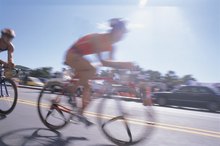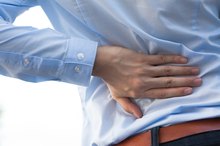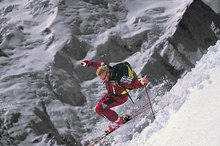What does fact checked mean?
At Healthfully, we strive to deliver objective content that is accurate and up-to-date. Our team periodically reviews articles in order to ensure content quality. The sources cited below consist of evidence from peer-reviewed journals, prominent medical organizations, academic associations, and government data.
The information contained on this site is for informational purposes only, and should not be used as a substitute for the advice of a professional health care provider. Please check with the appropriate physician regarding health questions and concerns. Although we strive to deliver accurate and up-to-date information, no guarantee to that effect is made.
Cycling With Pinched Nerves
Pinched nerves, or compressive neuropathy, result from too much pressure placed on a single nerve for an extended amount of time. The pressure inhibits the nerve's ability to function and can result in tingling and numbness. Pinched nerves are a common ailment of many cyclists and, if left untreated, can result in permanent nerve damage.
If you are experiencing serious medical symptoms, seek emergency treatment immediately.
Symptoms
Common areas of pinched nerves associated with cycling are the wrists, neck and back, although pinched nerves can occur anywhere in the body 1. The affected area may feel numb, may tingle as if “going asleep,” may radiate a sharp, burning pain from the inside out or may even feel weak or twitch occasionally.
Causes
What Causes Forarm Aches When Cycling?
Learn More
Pinched nerves associated with cycling are most often caused by poor posture, poor bike fit or an unchanged position after extended periods of riding. Numbness or tingling in the hands, specifically the ring and little finger, can be caused by extended pressure of the wrists on the handlebars combined with road vibrations through the bars. Pain in the neck is caused by stiffness while riding or neglecting to stop and stretch every 5 to 10 minutes. Lower back pain, or pain that radiates from the lower back down into the buttocks, is caused by poor posture habits both on and off the bike, a lack of stretching before and after riding and poor bicycle fit.
- Pinched nerves associated with cycling are most often caused by poor posture, poor bike fit or an unchanged position after extended periods of riding.
- Lower back pain, or pain that radiates from the lower back down into the buttocks, is caused by poor posture habits both on and off the bike, a lack of stretching before and after riding and poor bicycle fit.
Treatment
Once a pinched nerve develops, it can easily be treated and healed as long as the affected individual realizes the need for immediate treatment and rest. If you experience pain, numbness or tingling in any area of your body while riding, stop your exercise and give your nerves time to rest. Take this time to visit a bike shop and have them evaluate your riding posture and bike fit. If the pain does not subside in 5 to 10 days, consult your doctor. Your doctor might advise taking an anti-inflammatory medication to reduce any swelling in your muscles that could be putting pressure on your nerves. Physical therapy might also be recommended.
- Once a pinched nerve develops, it can easily be treated and healed as long as the affected individual realizes the need for immediate treatment and rest.
- If you experience pain, numbness or tingling in any area of your body while riding, stop your exercise and give your nerves time to rest.
Prevention
Testicle Damage From Cycling
Learn More
Evaluate your bike posture and redistribute your weight if your wrists, neck or back are in pain. Stretching your hamstrings before and after riding can help relieve pressure on your lower back. Incorporating abdominal crunches into your exercise routine will strengthen the muscles around your lower back and help condition you for longer rides and harder climbs, according to Cycling Performance Tips 1. In many cases, reexamining the size of your bike and finding a more suitable fit, as well as paying attention to proper posture on and off the bike, will help prevent future problems.
- Evaluate your bike posture and redistribute your weight if your wrists, neck or back are in pain.
- Incorporating abdominal crunches into your exercise routine will strengthen the muscles around your lower back and help condition you for longer rides and harder climbs, according to Cycling Performance Tips 1.
Related Articles
References
- Cycling Performance Tips.com: Back Pain and Neck Pain
- Hochman MG, Zilberfarb JL. Nerves in a pinch: imaging of nerve compression syndromes. Radiol Clin North Am. 2004;42(1):221-45. doi:10.1016/S0033-8389(03)00162-3
- NIH National Institute of Neurological Disorders and Stroke. Pinched nerve information page. Updated March 27, 2019.
- AdventHealth Medical Group. Cauda equina syndrome.
- AAOS OrthoInfo. Cervical radiculopathy (pinched nerve). Updated June 2015.
- Dimitrova A, Murchison C, Oken B. Acupuncture for the treatment of peripheral neuropathy: A systematic review and meta-analysis. J Altern Complement Med. 2017;23(3):164-179. doi:10.1089/acm.2016.0155
- Conger A, Cushman DM, Speckman RA, Burnham T, Teramoto M, McCormick ZL. The Effectiveness of Fluoroscopically Guided Cervical Transforaminal Epidural Steroid Injection for the Treatment of Radicular Pain; a Systematic Review and Meta-analysis. Pain Med. 2019 Jun 10. pii: pnz127. doi:10.1093/pm/pnz127 [Epub ahead of print]
- Keating L, Treanor C, Sugrue J, Meldrum D, Bolger C, Doody C. A randomised controlled trial of multimodal physiotherapy versus advice for recent onset, painful cervical radiculopathy - the PACeR trial protocol. BMC Musculoskelet Disord. 2019 Jun 1;20(1):265. doi:10.1186/s12891-019-2639-4
Writer Bio
Lily Obeck is a copywriter based in the Dallas-Fort Worth area. She writes for print, online, outdoor and broadcast marketing, with expertise in health, education and lifestyle topics. Obeck holds a Bachelor of Arts in English from the University of North Texas and works as a part-time children's library assistant.









